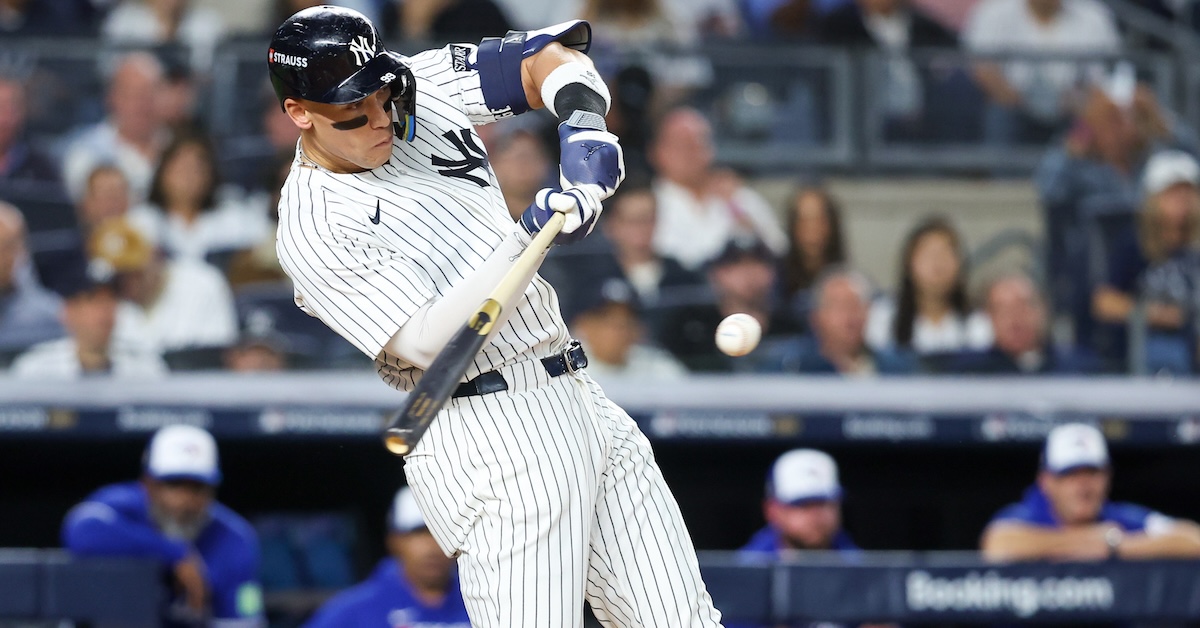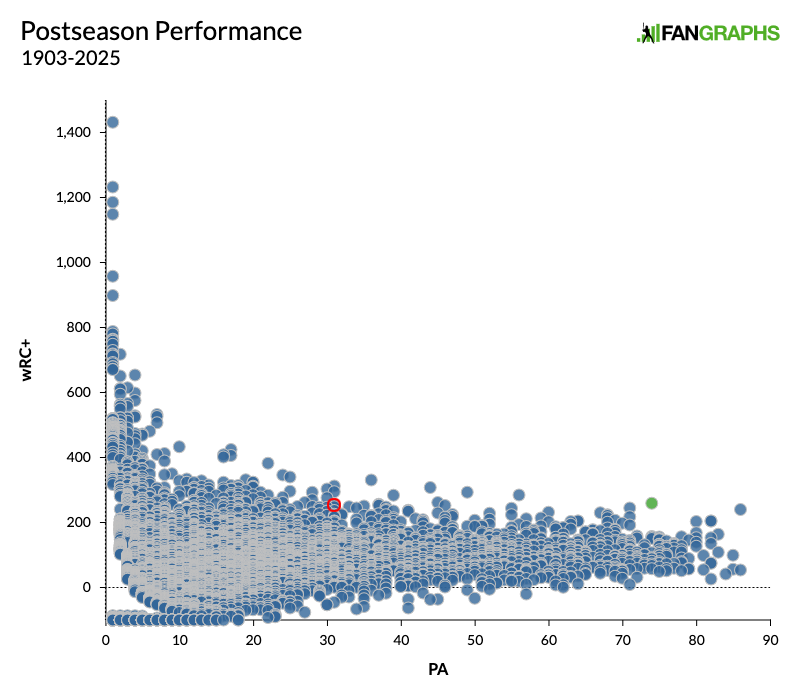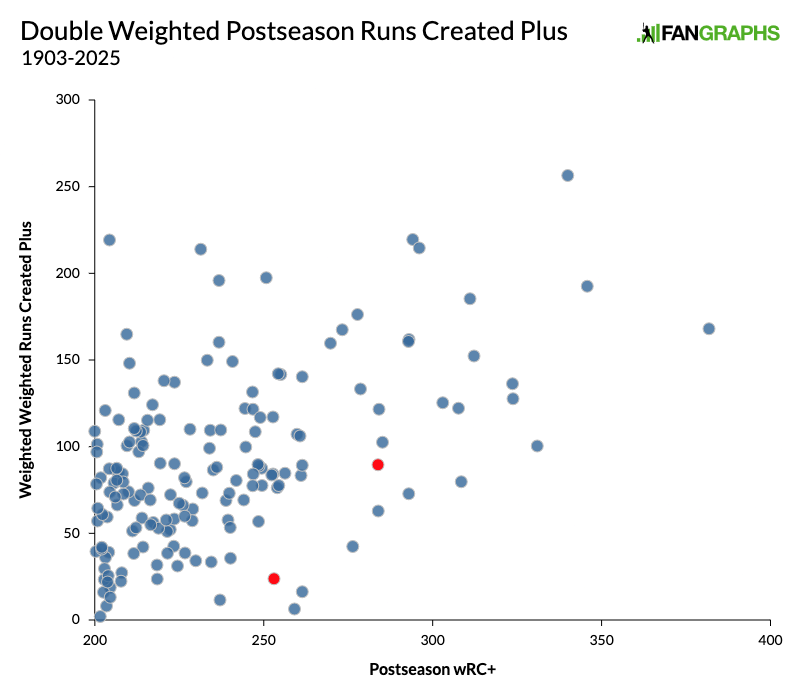Aaron Judge and the Greatest Postseasons of All Time

You may think you’ve already heard enough about Aaron Judge’s heroics during this postseason, especially considering that he wasn’t able to keep his team from getting knocked out barely a week into October. Heroes usually do a more thorough job when saving the day. I’m sure you’ve heard a lot about Judge’s 2025 playoff excellence. But I’d argue that you haven’t heard enough, because there’s a bit of context I’d like you to consider. That context? The entirety of postseason history.
Over the course of the American League Divisional Series against the Blue Jays, Judge batted .600. If you factor in his .354 batting average against the Red Sox in the Wild Card round, he batted an even .500 over 31 plate appearances this postseason. Now let’s head over to our handy-dandy postseason leaderboard. If you set a minimum of 30 PAs, you’ll find that Judge just ran the third-highest batting average ever over a single postseason; his .581 on-base percentage is the second highest. His 253 wRC+ is the 14th highest in postseason history (just behind the 255 mark that teammate Giancarlo Stanton put up in 2020). By that standard, Judge just produced one of the greatest postseason performances ever.
| Rank | Season | Name | Team | PA | HR | AVG | wRC+ |
|---|---|---|---|---|---|---|---|
| 1 | 2008 | Manny Ramirez | LAD | 36 | 4 | .520 | 331 |
| 2 | 1968 | Lou Brock | STL | 31 | 2 | .464 | 312 |
| 3 | 1989 | Rickey Henderson | OAK | 44 | 3 | .441 | 308 |
| 4 | 2024 | Fernando Tatis Jr. | SDP | 30 | 4 | .423 | 303 |
| 5 | 1990 | Billy Hatcher | CIN | 31 | 1 | .519 | 294 |
| 6 | 2023 | Yordan Alvarez | HOU | 49 | 6 | .465 | 293 |
| 7 | 2004 | Carlos Beltrán | HOU | 56 | 8 | .435 | 284 |
| 8 | 1989 | Will Clark | SFG | 39 | 2 | .472 | 284 |
| 9 | 1967 | Carl Yastrzemski | BOS | 30 | 3 | .400 | 276 |
| 10 | 1978 | Reggie Jackson | NYY | 45 | 4 | .417 | 262 |
| 11 | 2002 | Barry Bonds | SFG | 74 | 8 | .356 | 259 |
| 12 | 1984 | Alan Trammell | DET | 37 | 3 | .419 | 256 |
| 13 | 2020 | Giancarlo Stanton | NYY | 31 | 6 | .308 | 255 |
| 14 | 2025 | Aaron Judge | NYY | 31 | 1 | .500 | 253 |
| 15 | 1980 | Willie Aikens | KCR | 37 | 4 | .387 | 253 |
To be clear, those numbers are slightly misleading. We need to qualify them, but after I do so over the next couple paragraphs, I’m going to show you that even with all the right statistical context, this was still a very special run. Alright, now let’s do our sabermetric duty and throw some cold water on all of this.
The minimum of 30 plate appearances is important here. First, it rules out a huge chunk of postseason history. Until 1969, the postseason consisted only of the World Series, which sometimes goes as few as four games. To that point, baseball saw just 207 instances of players accumulating at least 30 PAs in a single World Series. No one ever made it to 40.
Next, the smaller the sample, the noisier the results. In postseason history, 171 different players have put up a wRC+ above 400, but none of them made more than 17 plate appearances and only five of them (including Babe Ruth and Lou Gehrig in 1928) made more than 10. On the other hand, the larger the sample, the more time there is for regression to the mean. Judge’s 253 wRC+ is amazing, but it’s much less amazing than the 245 that Barry Bonds ran over 74 plate appearances in 2002. The graph below shows every postseason performance in baseball history. Judge is the red circle and Bonds is the green one.

This certainly makes Judge look a bit less spectacular. He’s up toward the top of the heap for a player around 30 plate appearances, but he’s not standing out from the pack the way Bonds did. According to this chart, the most impressive performance in postseason history is undoubtedly Randy Arozarena’s magical, homer-filled 2020 run with the Rays, all the way to the right. With fewer than 100 regular season plate appearances under his belt, Arozarena somehow ran a 240 wRC+ over 86 PAs. He wouldn’t even win the Rookie of the Year until the next season! All of this is to say that Judge got just enough plate appearances to get to the point where he doesn’t really have to compete with players from before the divisional era, but few enough that he can still benefit from maximum variation. It’s a good sample-size sweet spot for looking like an outlier.
If we head over to Stathead and look not at whole individual postseasons, but rather postseason spans of seven games and at least 30 plate appearances, we find that 79 different players have put up stretches with a higher OPS than Judge’s 1.273 mark. It would be hard to argue that he actually put up the 14th-greatest postseason performance of all time. Now that we’ve put it in context, let’s talk about what makes it so special anyway.
First, it’s at least a little bit unfair to penalize Judge that harshly for the plate appearances he didn’t take. He did just about everything humanly possible to try to get the Yankees a deeper postseason run, and while his performance may have fallen back down to earth if he’d kept going into Game 5 or the ALCS, Judge has a career OPS of 1.018, and Stathead lists 189 different (though often overlapping) 15-game stretches during which he ran an OPS above 1.300. That’s a better performance over a period that’s twice as long. It’s not just possible that he could have kept this going; it’s something he’s done over and over again.
Next, if we go back to looking at complete postseasons, Judge is still an outlier even if you lower the plate appearances threshold. The list of player-postseasons with at least 20 PAs contains 10,842 entries. That’s a big sample, and within it, just 167 players have maintained a wRC+ of at least 200. Judge actually appears in the top 40 twice. He comes in 38th place this season, and his 2018 run of 22 PAs with a 284 wRC+ ranks 20th. By any measure, Judge has had two of the best complete postseason runs in baseball history. Moreover, he’s the only player who appears in the top 40 twice.
As you might recall, Judge was pretty good during the regular season, too. He led all of baseball in batting average (.331), on-base percentage (.457), and slugging (.688). He put up a major league-best 204 wRC+. That’s the 25th-highest mark ever among qualified batters, and it’s just the third-highest mark of Judge’s career! In the postseason, Judge increased his wRC+ by just under 49 points, an increase of 24%. Essentially, I just weighted Judge’s weighted runs created plus again, this time against his regular season numbers. It was fun, so I took all 167 of the individual player-postseasons with at least a 200 wRC+ over 20 or more plate appearances and weighted them the same way. Postseason wRC+ is on the x-axis, and the percentage above regular season performance is on the y-axis.

As you’d expect, the trendline goes from the bottom left to the top right. The better your postseason performance, the more likely you are to just be on a crazy, unsustainable hot streak that bears little relation to your regular season performance. The place to be is toward the the bottom right. If you’re down there, you’re putting up the best postseason numbers, but you’re not all that different from your regular season numbers. You’re performing well not because of an unsustainable streak, but because you’re just that good.
Now look at the two red dots. The one toward the very bottom is Judge in 2025, and the higher one is Judge in 2018. He’s right where you want to be. Few players have ever put up such a great postseason, and few players have ever looked more like themselves while they did it. If there’s such a thing as a believable 253 wRC+, Judge is one of just a few players ever to pull it off.
Before we finish here, I’d like to get away from wRC+, because as great as Judge was as an overall hitter, his batting average was probably the most impressive thing about this postseason. If you drop the plate appearances minimum to 20, he still just ran the 15th-best batting average in postseason history. If you drop it all the way to 15 PAs – that’s just three games for a player at the top of the lineup – he’s still tied for 24th. If this were 30 or 40 years ago, when batting average was still the be-all, end-all, we really would have considered this one of the greatest postseason performances of all time.
Davy Andrews is a Brooklyn-based musician and a writer at FanGraphs. He can be found on Bluesky @davyandrewsdavy.bsky.social.
I’ve basically stopped watching Yankees since they got Stanton when they already had Judge. At this point it is clear (to me at least) even Boone is not the biggest problem for the Yankees. Cashman is. While they have been clearly more successful, Yankees GM has seemed almost as clueless as a certain NY football team(!) in how to construct a balanced roster, let alone a championship one.
Do you think it was Cashman’s choice to cut payroll after making the World Series?
Or after losing Game 7 against the Astros?
There’s no GM who can fix this ownership.
I’m always happy for teams to use every possible dollar from their billionaire owners, but it seems disingenuous to me to act like the team with the 3rd highest payroll in the sport is being kneecapped by budgetary restrictions. Being the GM for the Yankees is hardly a hopeless predicament.
What does this even mean? What is a “balanced” roster? I’m not even trying to be facetious, I literally am trying to understand what that means in context here, especially with the (what appears to be a) random Jets slam in there.
I have had many, many problems with Cashman’s decision making. His track record of late is mixed — he’s had some notable hits and some wild misses. Being upset that they went out and got a good player when they already had a good player is…a weird hangup.
Was the 2025 Yankee roster perfect? No, not even close. Was it capable of winning a WS? I think so. Of course, they didn’t, but this wasn’t like 2022, where they were running on fumes and really didn’t have much business being there.
There usually isn’t some easy-to-diagnose fatal flaw. There isn’t some defect of personality or grit or whatever.
Sometimes, the other team plays better and you get beat. The Yankees’ two All-Star SPs threw two of their worst performances in back-to-back games (and they even managed to steal one of those back!).
That’s not to say that isn’t worth evaluating what went wrong and what could have been better — you should always do that, even when you win. But I also think that it makes sense to come at this with a mindset that recognizes the inherent variation of baseball — it is impossible to build a fool-proof roster, and to think that you can do so is folly.
I was wondering this too. Maybe you can fault the Yankees for not figuring out what they needed before the season started, and as a result they had to do a wild-card game instead of having a bye.
Aside from that, the team that went into the playoffs had three credible playoff starters, a top 3 offense (potentially best), a credible defense in both in the infield and outfield, and a lights out closer. They were a little on the left-handed side but against the Blue Jays that’s a good thing since their best starters are righties.
Really the only thing they could have done was win *one more game* during the regular season. The Blue Jays were fresh and the Yankees were not.
Oddly the pen was terrible apart from Bednar.
The following argument against the Yankees may not be right, but it is an honest attempts to understand the NYY. It came from Jomboy:
The only home grown hitter who worked out as a Yankee was Judge, who did not follow Yankee the player dev programme and got his own coaching Sanches, Volpe, Bird, Torres …we could go on… did not turn out. Why not? Maybe it is chance, but Yankee player dev hasn’t been good lately.
This, 100%, is on Cashman
Or maybe the postseason is just a crapshoot, at least to a much larger degree than the regular season is (where luck also plays a big role)?
If Austin Wells’ bases-loaded flyout was a fraction of an inch more on the sweet spot, we’d be talking about how great the Yankees are. Does that fraction of an inch suddenly make Cashman and Boone bad as opposed to good? It sounds ridiculous, doesn’t it? This was a team that nearly led all of MLB in run differential, had the best offense in the majors, and weathered the loss of about 10 WAR worth of starting pitching. They were certainly flawed, but (this year especially) all teams are.
The games are won by the players and they have to perform – in that sense the posteason is certainly measuring *something*, if not true team quality – but trying to pretend like a few millimeters (or any equivalent high leverage play that could have gone either way) makes the difference between *anyone* being “good” vs. “bad” is silly.
(notes that the Yankees were in WS last year, back in postseason again this year, then remembers northeastern sports fans are…special)
It is indeed clear that you haven’t been watching
I think any GM who can lead a team to 28 consecutive winning seasons and counting knows something about creating balanced rosters.
The amusement value of Yankee fans whining never gets old.
“While they have been clearly more successful, Yankees GM has seemed… clueless”
_____
So… you’re saying that their success is not indication of the GM?